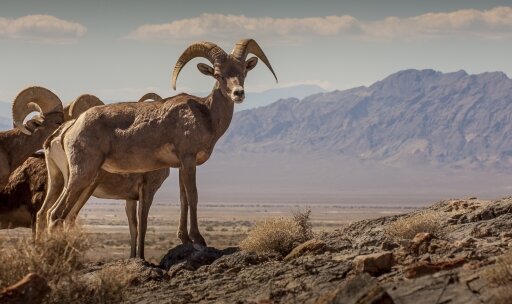Last week, supporters of the Desert National Wildlife Refuge in southern Nevada stormed Capitol Hill to ask lawmakers to continue the existing protections of this iconic refuge. The Air Force is proposing to expand their footprint into 1.1 million acres of the Refuge, essentially removing these acres from the Refuge System, totaling 5% of all refuge lands in the lower 48 states.
Desert Tortoise in Desert National Wildlife Refuge by Bureau of Land Management / Dana Wilson
Originally created in 1936 to protect the Desert bighorn sheep, the Desert NWR is 1.6 million acres—the largest land unit of the Refuge System outside Alaska. As the largest intact ecosystem for this species in the southwest, the refuge includes six mountain ranges, which are critical habitat for bighorn sheep. Recognizing the importance of this land, in 1974 President Nixon designated the vast majority of the refuge to be managed as wilderness, and much of it is still pristine.
In the 1940’s, the Air Force negotiated to take secondary jurisdiction over the western half of the refuge, in order to extend the Nevada Test and Training Range south and east. Further withdrawals have occurred since. While the U.S. Fish and Wildlife Service technically maintains primary jurisdiction over the majority of the refuge, the reality is that access to this western area by refuge staff is limited to less than two weeks a year. This area—860,000 acres total—is closed to the public, with the exception of very limited openings for sheep hunters. Vehicles are prohibited on roadless areas and no ground troops may train there. These areas are currently used as fly-over territory, with the occasional release of weaponry.
The eastern half of the refuge, which includes the rugged wilderness of the Sheep Range, is open to the public for hiking, hunting, camping and other activities.
NWRA's Acting Vice President of Government Affairs Caroline Brouwer at Desert NWR
In 1999, the Air Force successfully pushed for a transfer of jurisdiction of 112,000 acres in the western half of the refuge—the Air Force received primary and the Fish and Wildlife Service was reduced to secondary. In this area, the Air Force is doing aerial bombing, running ground missions, building infrastructure, and dumping contaminants. We’ve seen what the Air Force does with primary jurisdiction on the Desert NWR.
Every 20 years, the Air Force is required to come before Congress to extend its land withdrawals on the Refuge. This time around, the Air Force is requesting primary jurisdiction over all of the 860,000 acres in the western portion of the refuge where it currently has secondary jurisdiction, and topping that with primary jurisdiction over an additional 300,000 acres in the eastern portion of the refuge. This would be in effect a hand over of 1.1 million acres of the Desert NWR that currently protecting crucial habitat— to be used however the Air Force wants. Wildlife management priorities would no longer be required, or even considered.
Those 1.1 million acres represent 5% of all refuge lands in the lower 48 states.
A Walk In Desert National Wildlife Refuge by USFWS
In May, the Nevada State Legislature passed a bi-cameral, bi-partisan rebuke to the Air Force’s proposal, voting 58-3 to oppose the expansion.
Last week, conservation groups from Nevada and Washington, DC, including the National Wildlife Refuge Association, came to take action on Capitol Hill, sitting down with staff from 24 offices to advocate on behalf of the Desert NWR.
Lonely Mormon Well Road in Desert NWR by USFWS
With the current withdrawal deadline approaching in 2021, the Air Force has submitted their proposal to expand their land base. The Air Force already has total control of 3 million acres in southwest Nevada for the NTTR. Their current secondary jurisdiction over the western half of the Refuge allows total use of the airspace overhead and the occasional release of ordinance.
The 1.1 million acres in dispute include the iconic Sheep Range and would severely limit access to and risk the safety of tribal sites that are sacred to the Southern Paiute Tribe.
These 1.1 million acres include guzzlers, which provide water to innumerable species. Access to the guzzlers for repairs would be limited under these new proposals.
The 1.1 million acres include part of the Alamo Road, which is the only access point through the Desert Refuge from Las Vegas to the town of Alamo, and would eliminate any thru-access through the Refuge.
The 1.1 million acres include recreational areas that are currently open to the public, but would likely be forever closed.
In their Final Legislative Impact Statement and all throughout the public process, the Department of Defense has ignored the conservation community’s concerns about this proposed expansion. They have provided no argument for why they need to remove two-thirds of the Desert Refuge from the National Wildlife Refuge System. Yes, the military needs room for training purposes, and already has over 3 million acres in Nevada for this use.
We strongly support maintaining the current withdrawal agreement at the Desert National Wildlife Refuge over the next twenty years. We look forward to a cooperative and collaborative working relationship into the future between the US Fish & Wildlife Service and the US Air Force and encourage them to formalize a Memorandum of Agreement that would enable a positive and productive co-management relationship.
Look for more information to come. We expect withdrawal language to be included in next summer’s National Defense Authorization Act.







